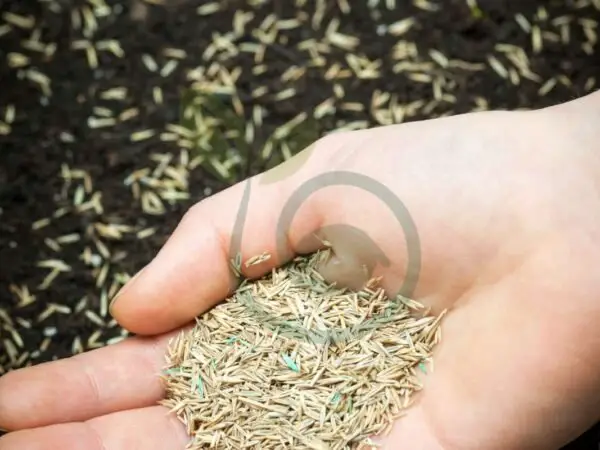Wondering if you can sow grass seed in the fall? Contrary to popular belief, autumn is an excellent time with warm soil to lay down grass seed for a lush, vibrant lawn. The cooler temperatures and increased moisture create optimal conditions for seed germination and root establishment. By seeding in the fall, you give your grass a head start before winter sets in, leading to a thicker, healthier lawn come spring.
Whether you are repairing bare patches or starting a new lawn from scratch, fall seeding can yield impressive results with minimal effort. Stay tuned as we delve into the benefits of planting grass seed in the autumn months and provide expert tips for achieving a verdant lawn that will be the envy of your neighborhood.
Key Takeaways
- Fall Seeding Benefits: Seeding in the fall can lead to stronger root development and healthier grass in the spring, taking advantage of cooler temperatures and increased moisture.
- Choose the Right Grass Seed: Select grass seed varieties that are suitable for your region and lawn conditions to ensure successful growth.
- Prepare Your Soil: Properly prepare the soil by clearing debris, loosening the top layer, and amending with compost or fertilizer to create an ideal environment for seed germination.
- Effective Seeding Techniques: Utilize techniques like overseeding, slit-seeding, or broadcasting to evenly distribute grass seed for optimal coverage.
- Proper Watering is Key: Consistent and deep watering is crucial after seeding to keep the soil moist but not waterlogged, promoting germination and root establishment.
- Fertilize Strategically: Apply a fall fertilizer with the right balance of nutrients to support grass growth without encouraging excessive top growth.
Benefits of Fall Seeding
Optimal Conditions
Choosing the right grass seed type is crucial for successful fall seeding. Ensure it is suitable for your region's climate and soil conditions. Check the soil temperature to ensure it promotes germination, typically around 50-65°F. Select a sunny area with good drainage to provide optimal growing conditions for the seeds.
Successful Germination
Keep the seeded area consistently moist by watering lightly daily. Avoid overwatering to prevent waterlogging, which can hinder germination. Look out for signs of germination such as tiny grass sprouts appearing within 1-3 weeks after seeding. Protect the newly germinated grass from foot traffic to allow it to establish firmly.
Repair Bare Spots
Assessing Damage
Identify areas with sparse or damaged grass that require reseeding in the fall. Check for signs of compacted soil, which can impede seed growth and root development. Look out for any pests or diseases that may be affecting your lawn's health and address them before seeding.
Soil Preparation
Loosen the soil in bare spots using a rake or garden fork to improve seed-to-soil contact, aiding in germination. Remove debris like rocks and weeds from the seeding area to create a clean environment for new grass growth. Consider adding organic matter like compost to enrich the soil with nutrients essential for healthy grass development.
Nourishing Your Lawn
Choosing Fertilizers
When selecting fertilizers, opt for products with a balanced nutrient composition suitable for promoting grass growth during fall months. Avoid high-nitrogen fertilizers as they can lead to excessive leaf growth at the expense of root development. Follow recommended application rates carefully to prevent burning your newly seeded lawn.
Application Timing
Determine the best time in fall based on your location's climate patterns and frost dates when planning to seed your lawn effectively. Consider upcoming weather conditions such as rainfall and temperature fluctuations that can impact seed germination success rates significantly. Plan ahead by allowing sufficient time before winter sets in so that new seeds have ample opportunity to establish strong roots.
Selecting Suitable Grass Seed
Grass Type Considerations
When choosing grass seed for fall planting, select varieties that thrive in cooler temperatures. Consider factors like shade tolerance and maintenance needs to ensure the new grass thrives. Mixing different grass species can create a more resilient lawn.
Climate Compatibility
Understand how your local climate impacts fall seeding success. Adjust seeding techniques based on temperature and rainfall patterns in your area. Choose grass varieties specifically tailored to thrive in your climate zone.
Enhancing Thin Lawns
Overseeding Techniques
- Prepare the existing lawn by mowing it short before overseeding.
- Use a broadcast spreader for even seed distribution.
- Consider aerating the lawn to improve seed-to-soil contact.
Seed Selection
- Pick high-quality grass seed with a high germination rate.
- Check for weed seed content in the grass seed mix.
- Consider using a seed blend for a diverse and robust lawn.
Soil Preparation Steps
Testing Soil pH
Conduct a soil pH test to determine acidity levels. Choose grass varieties suited to your lawn's pH. Add lime or sulfur for necessary adjustments.
Improving Soil Quality
Amend the soil with compost for nutrients. Use soil conditioners to enhance structure. Address compaction issues before seeding for optimal growth.
Ensuring Seed Contact
Raking Techniques
Use a rake lightly after spreading seed. Create shallow furrows for placement. Avoid raking too deeply to prevent burying seeds.
Soil Moisture Levels
Regularly monitor soil moisture post-seeding. Adjust watering based on weather conditions. Prevent soil dryness during germination period crucial for growth.
Seeding Techniques
Spreading the Seed
- Use a handheld spreader for small areas and a broadcast spreader for larger ones.
- Divide the seed into equal portions for even coverage. Walk in a consistent pattern.
- Ensure uniform seed distribution by walking in an organized and systematic manner.
Seed-to-Soil Contact
- Press the seeds lightly into the soil after spreading to enhance germination.
- Consider using a roller to improve seed-to-soil contact, aiding in successful growth.
- Avoid burying the seeds too deeply in the soil, as this can hinder germination.
Steps for Dormant Seeding
Timing and Temperature
- Seed when soil temperatures range between 50-65°F for optimal germination results.
- Avoid late fall seeding when temperatures plummet rapidly, affecting seed growth.
- Monitoring temperature accurately is crucial; consider using a soil thermometer.
Watering After Seeding
- Lightly water immediately after seeding to help settle the seeds into the soil.
- Keep the soil consistently moist by watering regularly post-seeding.
- Prevent washing away seeds by avoiding heavy watering that disrupts their placement.
Proper Watering Techniques
Initial Watering
When laying grass seed in the fall, start by using a fine mist setting on the hose to avoid displacing seeds. Water multiple times a day to ensure the soil remains consistently moist. Keep an eye out for any runoff, as it may indicate overwatering.
Maintaining Moisture
To maintain moisture levels, mulch the seeded area to help retain soil moisture and protect the seeds. Consider utilizing a soaker hose for deep watering that penetrates below the surface. As grass seedlings begin to grow, adjust your watering frequency accordingly.
Avoiding Overwatering
Prevent overwatering by allowing the soil surface to dry slightly between watering sessions. Be careful not to drown the seeds with excessive water, as this can hinder their growth. Watch out for signs of waterlogging, such as puddles forming on the lawn.
Fertilizing in Fall
Selecting Fertilizers
When considering fertilizers for fall, opt for products with a balanced mix of nitrogen, phosphorus, and potassium. These nutrients are crucial for the grass's overall health and growth. Choose slow-release fertilizers to ensure a continuous supply of nutrients over time. Follow the recommended schedule provided on the fertilizer packaging to achieve optimal results.
Fertilizer Application Schedule
Apply fertilizer after the new grass has been mowed a few times to allow it to establish strong roots. Avoid fertilizing during periods of drought or extreme heat as this can stress the grass. Consider splitting your fertilizer applications into multiple sessions to promote better nutrient absorption by the soil.
Monitoring Growth
Regularly inspect your lawn for signs of healthy growth such as vibrant green color and uniform thickness. Keep an eye out for any issues like discoloration, which could indicate nutrient deficiencies or other problems. If you notice stunted growth or patches of unhealthy grass, adjust your maintenance practices accordingly.
Lawn Maintenance Tips
Mowing Strategies
New grass should reach the recommended mowing height before you start cutting it. Using a sharp mower blade is crucial to avoid damaging the grass blades. When mowing, remember not to cut more than one-third of the grass blade length at once.
Weed Control
Regularly inspect your lawn for any signs of weeds and take action promptly. To prevent weed growth, consider using pre-emergent herbicides in your lawn maintenance routine. In newly seeded areas, opt for hand-pulling weeds instead of using harsh chemicals that could harm the young grass.
Preparing for Winter
To help your grass endure the cold winter months, apply a winterizing fertilizer as part of your fall lawn care regimen. Ensure that your lawn receives adequate water before entering its dormant phase in winter. Clear away any debris from the lawn surface to prevent it from smothering the grass during winter.
Late Fall Considerations
Dormancy Seeding Benefits
- Leverage the fall dormancy period for robust root system development.
- Expect earlier spring green-up by opting for dormant seeding in the fall.
- To ensure success, prevent foot traffic and heavy machinery on the freshly seeded area during dormancy.
Spring Growth Expectations
- Look forward to a lush, green lawn in the upcoming spring after fall seeding.
- Plan for routine tasks such as mowing and fertilizing to maintain your lawn's health.
- Witness a vibrant and healthy lawn as a result of your successful fall grass seed planting.
Summary
You've learned the benefits of fall seeding, how to select suitable grass seed, steps for soil preparation, seeding and watering techniques, fertilizing tips, lawn maintenance advice, and late fall considerations. By following these guidelines, you can ensure a successful fall seeding process and a healthy, vibrant lawn. Remember to continue proper maintenance throughout the season to support your grass's growth and resilience. Your efforts now will pay off in the form of a lush and beautiful lawn in the coming seasons. Take action today to lay the groundwork for a thriving lawn tomorrow.
Frequently Asked Questions
Can grass seed be planted in the fall?
Yes, you can plant grass seed in the fall. Fall seeding allows for optimal soil conditions and cooler temperatures that promote successful germination and root development before winter.
What type of grass seed is best for fall planting?
Choose cool-season grass seeds like fescue, bluegrass, or ryegrass for fall planting. These varieties thrive in cooler temperatures and establish strong roots during the fall season.
How should I prepare my soil before planting grass seed in the fall?
Prepare your soil by removing debris, tilling to loosen compacted areas, and adding organic matter like compost. Ensure the soil is well-drained to support healthy root growth for your new grass seed.
What are some effective techniques for seeding grass in the fall?
Use a broadcast spreader to evenly distribute the grass seed over your prepared soil. Rake lightly to cover the seeds with a thin layer of soil and press down gently to ensure good seed-to-soil contact.
How often should I water newly seeded grass in the fall?
Water newly seeded areas lightly multiple times a day to keep the topsoil moist but not waterlogged. Avoid letting the soil dry out completely as consistent moisture is crucial for successful germination.
Image Source: Paid image from CANVA



